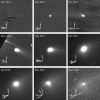The 67P/Churyumov-Gerasimenko observation campaign in support of the Rosetta mission
- PMID: 28554971
- PMCID: PMC5454223
- DOI: 10.1098/rsta.2016.0249
The 67P/Churyumov-Gerasimenko observation campaign in support of the Rosetta mission
Abstract
We present a summary of the campaign of remote observations that supported the European Space Agency's Rosetta mission. Telescopes across the globe (and in space) followed comet 67P/Churyumov-Gerasimenko from before Rosetta's arrival until nearly the end of the mission in September 2016. These provided essential data for mission planning, large-scale context information for the coma and tails beyond the spacecraft and a way to directly compare 67P with other comets. The observations revealed 67P to be a relatively 'well-behaved' comet, typical of Jupiter family comets and with activity patterns that repeat from orbit to orbit. Comparison between this large collection of telescopic observations and the in situ results from Rosetta will allow us to better understand comet coma chemistry and structure. This work is just beginning as the mission ends-in this paper, we present a summary of the ground-based observations and early results, and point to many questions that will be addressed in future studies.This article is part of the themed issue 'Cometary science after Rosetta'.
Keywords: Rosetta; comet 67P/Churyumov–Gerasimenko; observations.
© 2017 The Author(s).
Conflict of interest statement
The authors declare that they have no competing interests.
Figures











References
-
- Meech KJ. et al. 2011. EPOXI: Comet 103P/Hartley 2 observations from a worldwide campaign. Astrophys. J. 734, L1 (10.1088/2041-8205/734/1/L1) - DOI
-
- Schleicher DG. 2006. Compositional and physical results for Rosetta’s new target comet 67P/Churyumov Gerasimenko from narrowband photometry and imaging. Icarus 181, 442–457. (10.1016/j.icarus.2005.11.014) - DOI
-
- Mueller BEA. 1992. CCD-photometry of comets at large heliocentric distances. In Asteroids, comets, meteors 1991 (eds AW Harris, E Bowell), pp. 425–428. Houston, TX: Lunar and Planetary Institute.
-
- Lowry SC, Fitzsimmons A, Collander-Brown S. 2003. CCD photometry of distant comets. III. Ensemble properties of Jupiter-family comets. Astron. Astrophys. 397, 329–343. (10.1051/0004-6361:20021486) - DOI
Publication types
LinkOut - more resources
Full Text Sources
Other Literature Sources

